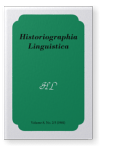Vol. 8:2/3 (1981) ► pp.345–356
The use of proper names as a testing device in Sībawayhi’s Kitāb
On numerous occasions Sībawayhi (d.2nd/8th century) asks his master al-Khalīl how certain elements (not necessarily nouns) would behave if used as a man or woman’s name. The purpose of these questions is evidently to test the morphological range of Arabic nouns, and proper names were chosen as the testing device because they are a class of nouns which can be arbitrarily coined from any source. At the same time the artificially created ‘name’ serves another purpose, i.e., to transfer a given element into the metalanguage. Several sets of examples are listed, in which various linguistic axioms can be seen to be tested, e.g. the minimal constituents of a noun, prosodie limitations, inflectional restrictions on nouns transferred from verbal and other categories, correlation between noun pattern and full or partial inflection, relationship between gender and inflection, assimilation by non-nouns to nearest available noun pattern on transfer to noun status, use of verbatim quotation when the limit of possible assimilation is passed (i.e., when phrases and sentences are used as proper names). Evidence is presented to show that both master and pupil were well aware of the opportunities afforded by the proper name for testing morphology (even of imaginary words) as well as for introducing items into the metalanguage. It is suggested that this procedure, if not actually invented by al-Khalīl, was certainly first elaborated and exploited by him. That the proper name test falls largely into disuse after the Kitāb is probably due to the shift away from descriptive and towards prescriptive grammar: other linguistic games emerge instead, which have an unmistakably pedagogical function, e.g. parsing exercises, constructing words from non-existent roots etc.
